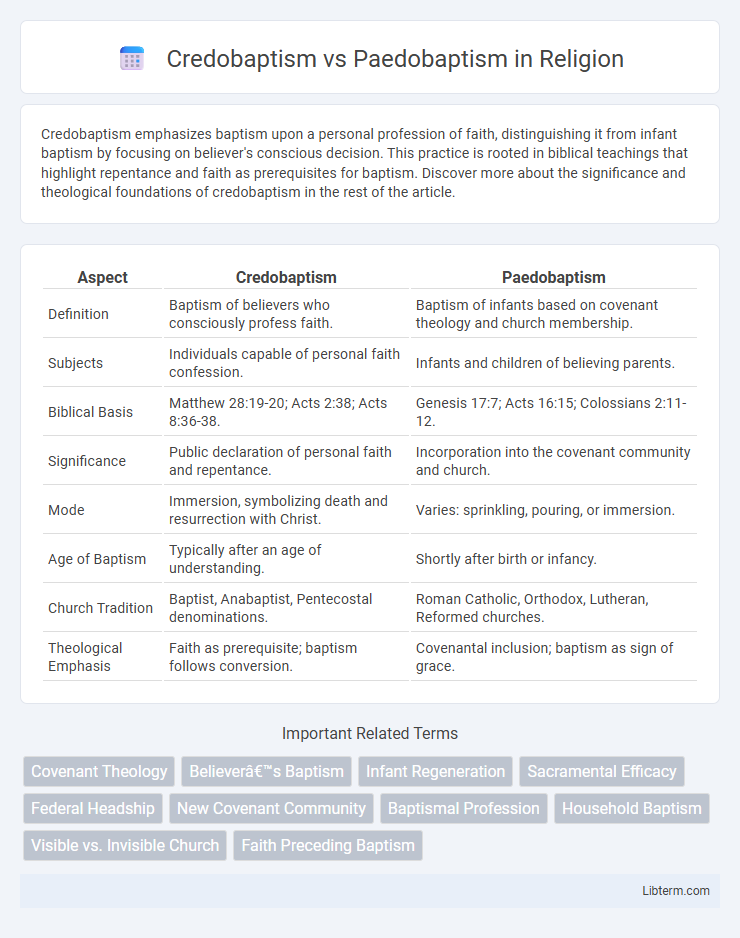Credobaptism emphasizes baptism upon a personal profession of faith, distinguishing it from infant baptism by focusing on believer's conscious decision. This practice is rooted in biblical teachings that highlight repentance and faith as prerequisites for baptism. Discover more about the significance and theological foundations of credobaptism in the rest of the article.
Table of Comparison
| Aspect | Credobaptism | Paedobaptism |
|---|---|---|
| Definition | Baptism of believers who consciously profess faith. | Baptism of infants based on covenant theology and church membership. |
| Subjects | Individuals capable of personal faith confession. | Infants and children of believing parents. |
| Biblical Basis | Matthew 28:19-20; Acts 2:38; Acts 8:36-38. | Genesis 17:7; Acts 16:15; Colossians 2:11-12. |
| Significance | Public declaration of personal faith and repentance. | Incorporation into the covenant community and church. |
| Mode | Immersion, symbolizing death and resurrection with Christ. | Varies: sprinkling, pouring, or immersion. |
| Age of Baptism | Typically after an age of understanding. | Shortly after birth or infancy. |
| Church Tradition | Baptist, Anabaptist, Pentecostal denominations. | Roman Catholic, Orthodox, Lutheran, Reformed churches. |
| Theological Emphasis | Faith as prerequisite; baptism follows conversion. | Covenantal inclusion; baptism as sign of grace. |
Introduction to Credobaptism and Paedobaptism
Credobaptism emphasizes baptism upon a profession of personal faith, typically practiced by believers who consciously decide to follow Christ, often adults and older children. Paedobaptism involves the baptism of infants or young children, based on the belief that baptism signifies covenant inclusion and divine grace extending to the household. These two approaches reflect fundamental theological differences regarding the nature of faith, covenant, and church membership.
Historical Roots and Development
Credobaptism, emphasizing believer's baptism upon profession of faith, traces its roots to the Anabaptist movement of the 16th century during the Protestant Reformation, rejecting infant baptism practiced in medieval Christianity. Paedobaptism, or infant baptism, originated from early Christian traditions and was formalized in the early church councils, reflecting theological views of covenant theology and church membership from the Patristic period onwards. The historical development of both baptismal practices highlights divergent interpretations of scripture, ecclesiology, and the theology of salvation that influenced numerous Protestant and Catholic denominations.
Key Theological Distinctions
Credobaptism emphasizes baptism as an outward profession of personal faith, typically administered to believers who consciously repent and confess Jesus Christ as Lord. Paedobaptism practices infant baptism, viewing it as a sign of the covenant and God's prevenient grace, incorporating children into the faith community. The theological debate hinges on covenant theology, the nature of faith and repentance, and the biblical interpretation of baptism's role in salvation and church membership.
Scriptural Basis for Credobaptism
Credobaptism finds strong Scriptural support in passages such as Acts 2:38 and Mark 16:16, where baptism follows an explicit profession of faith, emphasizing personal belief before immersion. The New Testament consistently illustrates baptism as an outward symbol of an inward transformation, experienced consciously by repentant believers rather than infants. This underscores the theological conviction that baptism should follow an individual's credible confession, aligning with the principle of believer's baptism found throughout the apostolic teaching.
Scriptural Basis for Paedobaptism
Paedobaptism is grounded in Scriptural passages such as Acts 16:15 and 1 Corinthians 1:16, where entire households, including children, were baptized, implying the inclusion of infants within the covenant community. Covenant theology interprets Genesis 17:7 and Colossians 2:11-12 as establishing a continuity between circumcision and baptism, positioning baptism as the New Testament sign of the covenant given to believers and their children. This interpretation emphasizes the parallel between Old Testament infant circumcision and New Testament infant baptism, reinforcing the practice's biblical foundation.
Arguments Supporting Credobaptism
Credobaptism emphasizes believer's baptism based on personal faith and repentance as a prerequisite, reflecting New Testament examples where baptism follows conversion (Acts 2:38, Romans 6:3-4). It argues that baptism symbolizes an individual's conscious commitment and public testimony of salvation, contrasting with paedobaptism's infant baptism practices that lack explicit biblical mandates. Advocates highlight the absence of infant baptism in early church records and stress the covenantal nature of baptism as requiring personal understanding and faith.
Arguments Supporting Paedobaptism
Paedobaptism is supported by scriptural references such as household baptisms in Acts 16:15 and 1 Corinthians 1:16, suggesting the inclusion of entire families, including children. Theologically, it emphasizes the covenantal continuity between Old Testament circumcision and New Testament baptism, marking children as members of the covenant community. Early church tradition also reflects widespread practice of infant baptism, reinforcing its historical and doctrinal legitimacy.
Impact on Church Practice and Membership
Credobaptism emphasizes believer's baptism, requiring personal confession of faith, which often results in a membership comprised of individuals who consciously affirm their commitment, fostering a community centered on personal conversion experiences. Paedobaptism practices infant baptism, integrating children into the church covenant community from an early age, which typically leads to a broader, generational membership inclusive of both baptized infants and adult converts. This distinction influences ecclesiastical practices, including membership qualifications, discipleship models, and church governance, shaping the theological identity and communal life of congregations.
Contemporary Debates and Perspectives
Contemporary debates on credobaptism versus paedobaptism center on theological interpretations of baptism's significance and subjects, with credobaptists emphasizing believer's personal faith as a prerequisite, while paedobaptists highlight covenant theology and infant inclusion. Recent perspectives analyze scriptural exegesis, historical church practices, and sociological implications, reflecting divergent views on covenant community membership. Scholarly discourse also addresses implications for ecclesiology, sacramental theology, and Christian identity within various denominational contexts.
Conclusion: Assessing the Ongoing Dialogue
Credobaptism emphasizes baptism upon a personal profession of faith, while Paedobaptism practices infant baptism as a sign of covenant inclusion. The ongoing dialogue between these views reflects deep theological convictions about faith, grace, and community identity. Evaluating both perspectives fosters mutual understanding and enriches ecclesiastical traditions without necessitating absolute consensus.
Credobaptism Infographic

 libterm.com
libterm.com